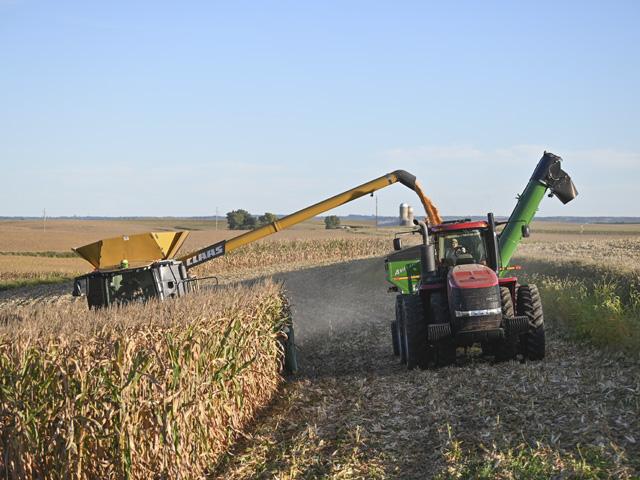Cattle Leverage Shift
CattleFax Sees Cow-Calf Producers' Piece of the Pie Getting Bigger
HOUSTON (DTN) -- The cattle market is "busting out" and there are good years ahead. Even better, cow-calf producers can expect more of the growing profits to stay on the farm as leverage continues to shift in that direction.
"We think about where we're at today, and it is an exciting time in our business," Kevin Good told attendees at this year's National Cattlemen's annual meeting last week. The longtime CattleFax analyst and vice president of industry relations noted cattle producers are doing more with less today, and the future is positive.
To get specific, beef's market share is at 48%, and beef demand, driven in large part by improved quality, is expected to stay strong. Per capita net beef consumption levels in 2022 are forecast down 2.1 pounds to 56.8 pounds. As for efficiency, today's industry produces 2.5 billion pounds more beef with 35 million fewer cattle. U.S. beef producers continue to lead the way as the most productive in the world.
Good put industry profitability expectations for 2022 at $800 per head. To put that into perspective, since 2000 industry profitability has averaged some $302 per head. This profit is split between four segments: cow-calf, stocker, fed cattle and packer. Good said herd liquidation and ongoing drought in parts of the country will shift a larger share of that profit away from packers and to the cow-calf producers.
CONTINUED LIQUIDATION
All of this bullish sentiment is, at its simplest level, tied to a shrinking U.S. beef cow herd, projected down 700,000 head this year. Good noted it is very possible the industry will see another 300,000 head drop in the cow herd in 2023. A natural outcome of that liquidation will be a drop in steer and heifer slaughter -- projected down 400,000 head in 2022. Overall, total slaughter is projected at 33 million head, down 680,000 head (-2%).
"Not only do we expect cow slaughter to stay elevated this year at a liquidation pace, but also let's remember we have 38% or more of our heifers on feed," Good said. "Till that number comes down, it suggests liquidation on the female side. Calf values will be high enough to expand, but you need green grass to get that accomplished."
PRICE OUTLOOK STRONG
Breaking out some price numbers for 2022, CattleFax analysts forecast an annual average for an 800-pound steer at $172/cwt, with a range of $158 to $184.
P[L1] D[0x0] M[300x250] OOP[F] ADUNIT[] T[]
For a 550-pound steer, that average is $205/cwt, with a range of $170/cwt to $230/cwt.
Utility cows are forecast at $75/cwt, with a range of $65/cwt to $85/cwt.
These prices will be supported for the next two to three years by expanding slaughter capacity, which will put packers in a competitive bidding mindset. By the 2024 and 2025 seasons, the forecast is that commercial cattle slaughter will be down 2.5 million head, while capacity has increased. Just how much capacity will climb remains to be seen, but Good said they are looking now at an additional capacity of 4,000 head per day, even though some indications call for twice that.
As this picture shifts, it will likely add to the leverage being built in that will favor the cow-calf operator in the coming years.
"The market has been balled up between $135/cwt and $138/cwt since the first of the year, this week we should get into trading higher levels," added Good.
CROPS PLANTED ACREAGE OUTLOOK
Mike Murphy, CattleFax vice president of research and risk management, updated producers on major crops. In brief, he said total planted acreage for principal crops will hold mostly steady compared to 2021. He does expect to see some major shifts in terms of what is planted on that acreage.
Projections point to a drop of about 1.6 million corn acres, taking that crop to 91.8 million acres. Yields are projected up slightly at 180.6 bushels per acre, (+3.6 bushels).
Murphy added the ethanol industry is working to build stocks during the 2021-22 marketing year and by 2022-23 will likely be close to mandated levels. With market volatility and China being a wild card on the export side, he said they are looking at prices staying high enough to ration at $5.90 a bushel for the 2021-22 marketing year; and $5.50 a bushel for 2022-23. The high end on the trading range would be $6.50 a bushel.
Offsetting corn's decrease in acres will be spring wheat with a 1.5-million-acre planting increase. Murphy also said winter wheat would likely see more acres, with an increase of 749,000 acres; and cotton would bump up 800,000 acres. Soybean area will hold mostly steady.
BIG PICTURE CALLS FOR PLANNING
While there was a lot of good news to share on the price front, CattleFax CEO Randy Blach took the opportunity to remind cattle producers to prepare for challenges in the months to come.
"This inflation trend is real," he said, stressing that they do not believe it's transitory. Blach compared today's economy to the 1970s, but added that agriculture is in better shape with less debt and more equity than it had in the 1970s.
"The expectation should be that it will push costs up," he said of inflation. "Crude oil prices will have significant upside risk the next 12 to 24 months. Everything we use will go up. The cost of end products will move higher, and the cost of doing business will be higher. You need to take that into account as you plot your course down the road."
Victoria Myers can be reached at vicki.myers@dtn.com
Follow her on Twitter @myersPF
(c) Copyright 2022 DTN, LLC. All rights reserved.






